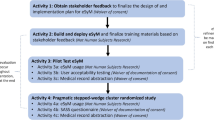Abstract
Background
Use of electronic patient-reported outcomes (ePROs) in routine cancer care can help identify troublesome symptoms and facilitate discussions between patients and clinicians and has been shown to improve patient satisfaction, quality of life, and survival.
Methods
Eighty patients with stage IV non-hematologic malignancies on chemotherapy participated. Patient-Reported Symptom Monitoring (PRSM) surveys were sent every 14 days via the Epic MyChart system over a 12-week period. Surveys were offered via phone or paper if patients failed to complete the automated MyChart survey by day 16. Severe symptoms or concerning symptom trends were automatically highlighted in reports for clinic staff. Patients reporting severe symptoms were routed to oncology nursing triage for standard symptom care management.
Results
Two hundred seventy-one surveys were sent during the 12-week study period. One hundred eighty-three surveys (66%) were completed, with 68% completed electronically via MyChart, 25% by paper, and 7% by phone call from a research coordinator. At least one severe symptom was reported on 36% of all surveys. However, most severe symptoms did not result in urgent triage follow-up because they were already being addressed and/or patients felt they were manageable. Patients and clinicians generally said the ePRO was efficient and helpful for addressing distressing symptoms and would use it in routine oncology care.
Conclusion
ePROs can be integrated into the electronic health record using the Epic MyChart system. Patients and clinicians gave positive feedback on the system. Monitoring symptoms in real time may soon become part of standard oncology practice and requires seamless methods for collection.





Similar content being viewed by others
References
Von Roenn JH, Temel J (2011) The integration of palliative care and oncology: the evidence. Oncology (Williston Park) 25(13):1258–1260 1262, 1264–5
Halabi S, Vogelzang NJ, Kornblith A (2008) Pain predicts overall survival in men with metastatic castration-refractory prostate cancer. J Clin Oncol 26(15):2544–2549
Quinten C, Coens C, Mauer M (2009) Baseline quality of life as a prognostic indicator of survival: a meta-analysis of individual patient data from EORTC clinical trials. Lancet Oncol 10:865–871
Basch E, Deal AM, Dueck AC (2017) Overall survival results of a trial assessing patient-reported outcomes for symptom monitoring during routine cancer treatment. JAMA 318(2):197–198
Laugsand EA, Sprangers MA, Bjordal K (2010) Health care providers underestimate symptom intensities of cancer patients: a multicenter European study. Health Qual Life Outcomes 8:104
Basch E, Jia X, Heller G (2009) Adverse symptom event reporting by patients vs clinicians: relationships with clinical outcomes. J Natl Cancer Inst 101(23):1624–1632
Stover A et al (2015) Integrating patient-reported outcome measures into routine cancer care: cancer patients’ and clinicians’ perceptions of acceptability and value. EGEMS (Wash DC) 3(1):1169
Cleeland C, Wang X, Shi Q (2011) Automated symptom alerts reduce postoperative symptom severity after cancer surgery: a randomized controlled clinical trial. J Clin Oncol 29(8):994–1000
Basch E (2014) The rationale for collecting patient-reported symptoms during routine chemotherapy. Am Soc Clin Oncol Educ Book:161–165
Bennett AV, Jensen RE, Basch E (2012) Electronic patient-reported outcome systems in oncology clinical practice. CA Cancer J Clin 62(5):337–347
Kotronoulas G, Kearney N, Maguire R (2014) What is the value of the routine use of patient-reported outcome measures toward improvement of patient outcomes, processes of care, and health service outcomes in cancer care? A systematic review of controlled trials. J Clin Oncol 32(14):1480–1501
Berry DL, Blumenstein BA, Halpenny B (2011) Enhancing patient-provider communication with the electronic self-report assessment for cancer: a randomized trial. J Clin Oncol 29(8):1029–1035
Basch E, Abernethy AP (2011) Supporting clinical practice decisions with real-time patient-reported outcomes. J Clin Oncol 29(8):954–956
Wagner LI, Schink J, Bass M (2015) Bringing PROMIS to practice: brief and precise symptom screening in ambulatory cancer center. Cancer 121(6):927–934
Basch E, Barbera L, Kerrigan CL (2018) Implementation of patient-reported outcomes in routine medical care. Am Soc Clin Oncol Book 38:122–134
Basch E, Abernethy AP, Mullins CD, Reeve BB, Smith ML, Coons SJ, Sloan J, Wenzel K, Chauhan C, Eppard W, Frank ES, Lipscomb J, Raymond SA, Spencer M, Tunis S (2012) Recommendations for incorporating patient-reported outcomes into clinical comparative effectiveness research in adult oncology. J Clin Oncol 30(34):4249–4255
Jensen RE et al (2014) Review of electronic patient-reported outcomes systems used in cancer clinical care. J Oncol Pract 10(4):e215–e222
Basch E, Deal AM, Kris MG (2016) Symptom monitoring with patient-reported outcomes during routine cancer treatment: a randomized controlled trial. J Clin Oncol 34:557–565
Shapiro CL (2018) Cancer survivorship. N Engl J Med 379(25):2438–2450
Gilmer TP, O’Connor PJ, Sperl-Hillen JM (2012) Cost-effectiveness of an electronic medical record based clinical decision support system. Health Serv Res 47(6):2137–2158
O’Connor PJ, Sperl-Hillen JM, Rush WA, Johnson PE, Amundson GH, Asche SE, Ekstrom HL, Gilmer TP (2011) Impact of electronic health record clinical decision support on diabetes care: a randomized trial. Ann Fam Med 9(1):12–21
Acknowledgments
The authors would like to thank Jan Morgan for the help with study coordination, Mary VanBeusekom for the review of the manuscript, and Min Xi for the help with initial data analysis.
Funding
This study was financially supported by a Program Development Grant from Health Partners Institute
Author information
Authors and Affiliations
Corresponding author
Ethics declarations
The study was approved by the Institutional Review Board at Health Partners Institute. Informed consent was obtained from all individual participants included in the study
Conflict of interest
The authors declare that they have no conflict of interest.
Additional information
Publisher’s note
Springer Nature remains neutral with regard to jurisdictional claims in published maps and institutional affiliations.
Rights and permissions
About this article
Cite this article
Zylla, D.M., Gilmore, G.E., Steele, G.L. et al. Collection of electronic patient-reported symptoms in patients with advanced cancer using Epic MyChart surveys. Support Care Cancer 28, 3153–3163 (2020). https://doi.org/10.1007/s00520-019-05109-0
Received:
Accepted:
Published:
Issue Date:
DOI: https://doi.org/10.1007/s00520-019-05109-0



